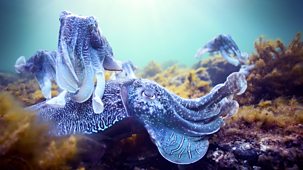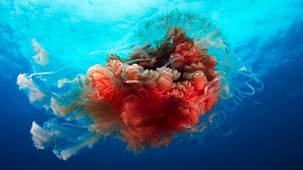
Series 1: 5. Green Seas
It's our green seas, not the blue, that bring life to our oceans. Here sunlight powers the growth of enchanted forests of kelp, mangroves and prairies of sea grass. They are the most abundant but fiercely competitive places in the ocean to live.\n\nThe most bountiful kelp forests are found off the tip of southern Africa, where two great oceans collide. Almost a hundred different species of shark patrol these waters, driving one resident - the common octopus - to become the ultimate escape artist. To outwit her nemesis, the pyjama shark, she uses ingenious tactics, never filmed before. \n\nAlong the Pacific coast of North America stand, at 60 metres high, the largest and perhaps most diverse kelp forests in the world. In clearings, bright orange male Garibaldi fish guard territories of short turf seaweed. When spiny urchins invade and graze their crops, the Garibaldi desperately pick them off. But urchins can swarm in vast numbers and even attack and fell the kelp forest itself, creating vast 'urchin barrens'. All is not entirely lost, thanks to the return of a ravenous forest resident - sea otters. Back in the late 1800s, sea otters were hunted for their thick pelts to near extinction. And with them gone, urchin numbers rose, destroying many forests. Today, thanks to protection, sea otter numbers are recovering, along with the health of the forest. In a filming first, we reveal great rafts of sea otters now numbering in their hundreds. \n\nIn warmer waters another green sea takes hold. Off Western Australia, vast prairies of seagrass extend to the horizon. Here, grazing green turtles are stalked by tiger sharks. By keeping turtles on the move, tiger sharks prevent the seagrass meadows from being overgrazed. In this way, sharks have become surprising allies in the fight against climate change - as a patch of sea grass is 35 times more efficient at absorbing and storing carbon than the same area of rainforest.\n\nOnce a year, one sea meadow in Australia is overrun by an extraordinary invasion. With the first full moon of winter, strange creatures emerge from the deep - spider crabs. The army marches into the shallows and starts to pile one on top of each other, building mounds over a metre high. They then moult. Soft-bodied and weakened, they must avoid the patrolling four-metre-long stingrays.\n\nFurther along the coast, the greatest gathering of cuttlefish in the world takes place, as males battle it out for the right to mate. But even among these giant cuttlefish, the largest of their kind, it's not always size that counts. A smaller, sneaky male uses subterfuge, even pretending to be a female, to confuse rivals and get his girl. Even raising your young can be tough in such a competitive place. A weedy seadragon sets out on an epic quest to give his young the very best start in life.\n\nVast numbers of the ocean's baby fish start their lives in the green seas. The richest nurseries of all are the mangrove forests. Straddling the boundary between land and sea, they provide shelter for the juvenile fish. But in the mangroves of Western Australia lives a deadly assassin - the 40cm-long zebra mantis shrimp. In a surprising story of betrayal, a male shrimp will abandon his mate of possibly 20 years, trading up for a larger female.\n\nAnd there is one other green sea that supports more life than all the rest combined. Unlike the mangrove forests and prairies of sea grass, its existence in the open seas is only temporary. Microscopic algae flourish into vast blooms, providing a feast for plankton-feeding fish like billions of anchovies. In Monterey Bay, California, the giant shoals draw in thousands of dolphins, sea lions and humpback whales who all race to claim their share of the feast.
Source: BBC 1
Most recent episodes of Blue Planet II
Blue Planet Ii
Oceans Of Wonder
This extended special of the nature documentary series journeys from the equator to the unexplored depths, meeting the best-loved characters from the series.
29-12-2025
BBC 1
Blue Planet Ii
Series 1: 5. Green Seas
It's our green seas, not the blue, that bring life to our oceans. Here sunlight powers the growth of enchanted forests of kelp, mangroves and prairies of sea grass. They are the ...
23-11-2025
BBC 1
Blue Planet Ii
Series 1: 4. Big Blue
The big blue is the world's greatest wilderness, far from shore and many kilometres deep. It's a vast marine desert where there is little to eat and nowhere to hide. Yet it's ho ...
02-11-2025
BBC 1
Blue Planet Ii
Series 1: 2. The Deep
The deep is perhaps the most hostile environment on earth, at least to us - a world of crushing pressure, brutal cold and utter darkness. We have barely begun to explore it, and ...
19-10-2025
BBC 1
Blue Planet Ii
Series 1: 7. Our Blue Planet
While making Blue Planet II, we have explored parts of the ocean that nobody has been to before, encountered extraordinary animals and discovered new insights into how life thri ...
09-03-2025
BBC 1
Blue Planet Ii
Series 1: 6. Coasts
On the coast, two worlds collide. Coasts are the most dynamic and challenging habitats in the ocean - that brings great rewards but also great danger. The extraordinary animals ...
03-03-2025
BBC 1
Blue Planet Ii
Series 1: 3. Coral Reefs
Corals build themselves homes of limestone in the warm, clear, shallow seas of the tropics. Their reefs occupy less than one tenth of one per cent of the ocean floor, yet they a ...
26-02-2025
BBC 1
Most popular episodes of Blue Planet II
Blue Planet Ii
Series 1: 7. Our Blue Planet
While making Blue Planet II, we have explored parts of the ocean that nobody has been to before, encountered extraordinary animals and discovered new insights into how life thri ...
09-03-2025
BBC 1
Blue Planet Ii
Series 1: 4. Big Blue
The big blue is the world's greatest wilderness, far from shore and many kilometres deep. It's a vast marine desert where there is little to eat and nowhere to hide. Yet it's ho ...
02-11-2025
BBC 1
Blue Planet Ii
Oceans Of Wonder
This extended special of the nature documentary series journeys from the equator to the unexplored depths, meeting the best-loved characters from the series.
29-12-2025
BBC 1
Blue Planet Ii
Series 1: 3. Coral Reefs
Corals build themselves homes of limestone in the warm, clear, shallow seas of the tropics. Their reefs occupy less than one tenth of one per cent of the ocean floor, yet they a ...
26-02-2025
BBC 1
Blue Planet Ii
Series 1: 6. Coasts
On the coast, two worlds collide. Coasts are the most dynamic and challenging habitats in the ocean - that brings great rewards but also great danger. The extraordinary animals ...
03-03-2025
BBC 1
Blue Planet Ii
Series 1: 5. Green Seas
It's our green seas, not the blue, that bring life to our oceans. Here sunlight powers the growth of enchanted forests of kelp, mangroves and prairies of sea grass. They are the ...
23-11-2025
BBC 1
Blue Planet Ii
Series 1: 2. The Deep
The deep is perhaps the most hostile environment on earth, at least to us - a world of crushing pressure, brutal cold and utter darkness. We have barely begun to explore it, and ...
19-10-2025
BBC 1








